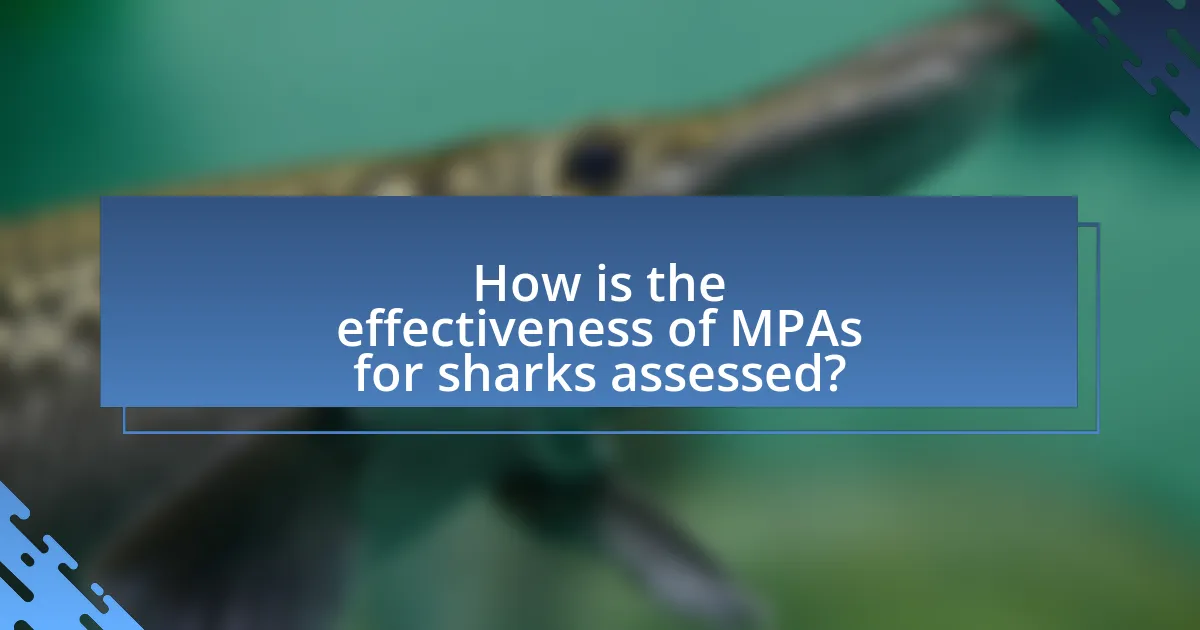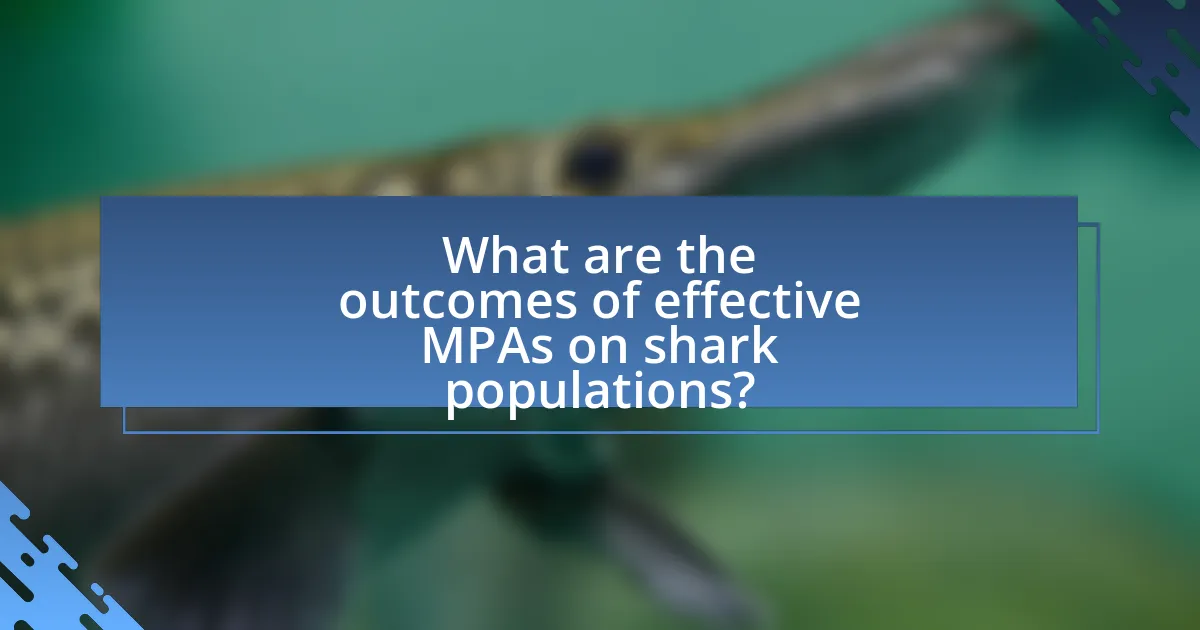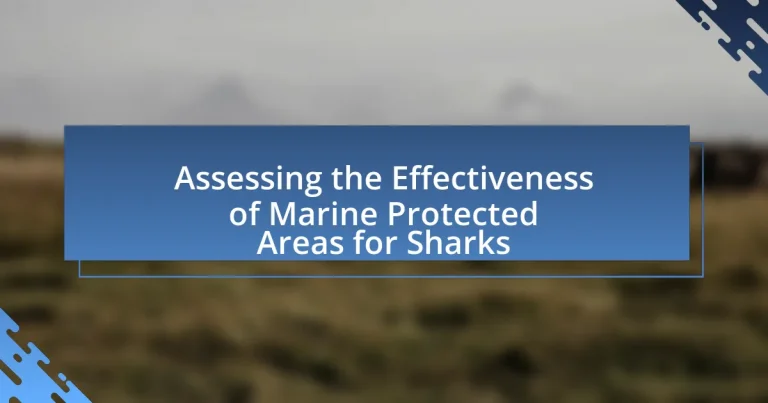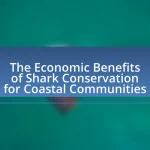Marine Protected Areas (MPAs) are designated regions in oceans and coastal environments aimed at conserving marine ecosystems and biodiversity, with particular relevance to shark populations. This article examines the effectiveness of MPAs in supporting shark conservation by providing critical habitats for breeding, feeding, and migration, which are essential for their survival. It discusses the various types of MPAs, their specific protections for sharks, and the positive impacts on shark behavior, reproductive success, and overall marine ecosystem health. Additionally, the article highlights the socio-economic implications of MPAs for local communities and the importance of stakeholder engagement and ongoing research in optimizing MPA management for shark conservation.
-and-their-relevance-to-sharks-1.webp)
What are Marine Protected Areas (MPAs) and their relevance to sharks?
Marine Protected Areas (MPAs) are designated regions in oceans and coastal environments where human activities are regulated to conserve marine ecosystems and biodiversity. MPAs are particularly relevant to sharks as they provide critical habitats for breeding, feeding, and migration, which are essential for their survival and population recovery. Research indicates that MPAs can lead to increased shark populations and biodiversity, as evidenced by studies showing that shark abundance can be significantly higher in protected areas compared to unprotected regions. For instance, a study published in the journal “Conservation Biology” found that MPAs in the Caribbean resulted in a 50% increase in shark populations over a five-year period, highlighting their effectiveness in supporting shark conservation efforts.
How do MPAs contribute to shark conservation?
Marine Protected Areas (MPAs) contribute to shark conservation by providing designated habitats where sharks can thrive without the pressures of fishing and habitat degradation. These protected zones help to increase shark populations by allowing them to reproduce and grow in a safe environment. Research indicates that MPAs can lead to a significant increase in shark biomass, with studies showing that areas with strong protection can see up to a 200% increase in shark populations over time. Additionally, MPAs help to maintain the ecological balance of marine ecosystems, which is crucial for the survival of sharks and their prey.
What specific protections do MPAs offer to shark populations?
Marine Protected Areas (MPAs) offer specific protections to shark populations by restricting fishing activities and habitat destruction within designated zones. These restrictions help to reduce mortality rates and allow for the recovery of overfished shark species. For instance, studies have shown that MPAs can lead to increased shark abundance and diversity, as evidenced by research conducted in the Bahamas, where the establishment of MPAs resulted in a 50% increase in shark populations over a five-year period. Additionally, MPAs provide critical habitats for breeding and nursery grounds, which are essential for the life cycle of many shark species, further enhancing their chances of survival and reproduction.
How do MPAs impact the overall health of marine ecosystems for sharks?
Marine Protected Areas (MPAs) significantly enhance the overall health of marine ecosystems for sharks by providing critical habitats and reducing human-induced stressors. MPAs create safe zones where shark populations can recover and thrive, leading to increased biodiversity and stability within the ecosystem. Research indicates that areas designated as MPAs often show higher shark abundance and diversity compared to unprotected areas, with studies revealing that shark populations can increase by up to 50% within a few years of MPA establishment. This recovery contributes to the balance of marine food webs, as sharks play a vital role as apex predators, regulating prey populations and maintaining ecosystem health.
What are the different types of MPAs that exist?
Marine Protected Areas (MPAs) can be categorized into several types based on their management objectives and restrictions. The primary types include:
- No-Take Zones: Areas where all forms of extraction, including fishing and harvesting, are prohibited to protect marine life and habitats.
- Multiple-Use MPAs: Zones that allow various activities, such as fishing, tourism, and recreation, but with specific regulations to ensure sustainability.
- Marine Reserves: Areas designated for the conservation of marine biodiversity, often with strict regulations against human activities.
- Seasonal Closures: MPAs that are temporarily closed to certain activities during critical periods, such as breeding seasons, to protect vulnerable species.
- Community-Managed MPAs: Areas managed by local communities, often incorporating traditional knowledge and practices to sustain marine resources.
These classifications help in the effective management and conservation of marine ecosystems, particularly for species like sharks, which are often vulnerable to overfishing and habitat degradation.
What distinguishes no-take zones from other types of MPAs?
No-take zones are distinguished from other types of Marine Protected Areas (MPAs) by their strict prohibition of all extractive activities, including fishing and resource harvesting. This regulation aims to create a sanctuary for marine life, allowing ecosystems to recover and thrive without human interference. Research indicates that no-take zones can lead to increased biodiversity and biomass, as evidenced by studies showing that fish populations within these areas can be significantly higher compared to fished zones, with some studies reporting up to a 400% increase in fish density.
How do seasonal closures within MPAs affect shark populations?
Seasonal closures within Marine Protected Areas (MPAs) positively affect shark populations by providing critical periods of refuge from fishing pressures. These closures allow sharks to reproduce and grow without the threat of being caught, leading to increased population densities and improved reproductive success. Research indicates that areas with seasonal closures show higher shark abundance and diversity compared to fished areas, as evidenced by studies conducted in the Bahamas and the Great Barrier Reef, where significant increases in shark populations were documented following the implementation of such closures.

How is the effectiveness of MPAs for sharks assessed?
The effectiveness of Marine Protected Areas (MPAs) for sharks is assessed through various methods, including population monitoring, habitat assessments, and behavioral studies. Population monitoring involves tracking shark abundance and diversity within MPAs compared to unprotected areas, often using techniques such as underwater visual surveys and tagging. Habitat assessments evaluate the quality and extent of critical habitats, such as nursery grounds, to determine if MPAs provide suitable environments for shark species. Behavioral studies analyze shark movement patterns and residency times within MPAs, providing insights into the areas’ effectiveness in offering protection. Research has shown that MPAs can lead to increased shark populations and improved biodiversity, with studies indicating that well-managed MPAs can enhance shark biomass by up to 50% compared to adjacent unprotected areas.
What metrics are used to evaluate the success of MPAs for shark conservation?
Metrics used to evaluate the success of Marine Protected Areas (MPAs) for shark conservation include shark population density, species diversity, reproductive success, and habitat health. Shark population density is measured through underwater surveys and catch data, indicating the abundance of sharks within the MPA. Species diversity assesses the variety of shark species present, which reflects the ecological health of the area. Reproductive success is evaluated by monitoring breeding behaviors and juvenile shark populations, providing insights into the sustainability of shark populations. Habitat health is assessed through environmental indicators such as water quality and the presence of essential habitats like nurseries and feeding grounds. These metrics collectively provide a comprehensive understanding of the effectiveness of MPAs in conserving shark populations.
How do population trends of sharks indicate MPA effectiveness?
Population trends of sharks serve as a key indicator of Marine Protected Area (MPA) effectiveness by reflecting changes in abundance and diversity within these designated zones. When shark populations increase within an MPA, it suggests that the protective measures are successfully reducing fishing pressure and habitat degradation, allowing for recovery and growth. For instance, studies have shown that in the Bahamas, the establishment of MPAs led to a 200% increase in shark populations over a decade, demonstrating the positive impact of protection on species recovery. Conversely, stagnant or declining shark populations within MPAs may indicate insufficient enforcement or other ecological pressures, thus signaling a need for management adjustments. Therefore, monitoring shark population trends provides critical insights into the success and areas for improvement of MPAs in conserving marine biodiversity.
What role does biodiversity play in assessing MPA success for sharks?
Biodiversity is crucial in assessing the success of Marine Protected Areas (MPAs) for sharks, as it reflects the health and resilience of marine ecosystems. High biodiversity within an MPA indicates a stable environment that can support various shark species, which are often indicators of ecosystem health. Studies have shown that MPAs with greater biodiversity tend to have higher populations of sharks, as these areas provide essential habitats and resources. For instance, research published in “Conservation Biology” by McCauley et al. (2015) demonstrated that MPAs with diverse marine life had significantly higher shark densities compared to less biodiverse areas. This correlation underscores the importance of biodiversity as a metric for evaluating MPA effectiveness in conserving shark populations.
What challenges exist in assessing MPA effectiveness for sharks?
Assessing the effectiveness of Marine Protected Areas (MPAs) for sharks faces several challenges, primarily due to the mobility and behavioral patterns of sharks. Sharks often migrate over large distances, making it difficult to determine whether observed population changes are directly attributable to MPA protections or external factors. Additionally, the lack of baseline data on shark populations before MPA implementation complicates the assessment of their effectiveness. Studies have shown that many MPAs are not adequately enforced, leading to illegal fishing activities that undermine conservation efforts. Furthermore, the ecological role of sharks in marine ecosystems is complex, and their responses to protection measures can vary significantly among species, adding another layer of difficulty in evaluating MPA success.
How do external factors influence the assessment of MPAs?
External factors significantly influence the assessment of Marine Protected Areas (MPAs) by affecting ecological conditions, stakeholder engagement, and regulatory frameworks. For instance, climate change alters marine ecosystems, impacting species distribution and habitat quality, which can skew assessment outcomes. Additionally, socio-economic factors, such as local fishing practices and tourism, shape stakeholder perceptions and compliance with MPA regulations, thereby influencing the effectiveness of conservation efforts. Research indicates that MPAs in regions with strong community involvement and adaptive management strategies tend to show better ecological outcomes, highlighting the importance of integrating external social and environmental factors into MPA assessments.
What are the limitations of current assessment methodologies?
Current assessment methodologies for evaluating the effectiveness of Marine Protected Areas (MPAs) for sharks have several limitations. These methodologies often rely on inadequate data collection, which can lead to biased or incomplete assessments of shark populations and their habitats. For instance, many assessments do not account for the migratory nature of sharks, resulting in an underestimation of their population dynamics and ecological roles. Additionally, existing methodologies frequently lack standardized metrics, making it difficult to compare results across different MPAs or studies. This inconsistency can hinder the ability to draw meaningful conclusions about the overall effectiveness of MPAs in conserving shark populations. Furthermore, many methodologies focus primarily on short-term outcomes rather than long-term ecological impacts, which can obscure the true benefits of MPAs over time.

What are the outcomes of effective MPAs on shark populations?
Effective Marine Protected Areas (MPAs) lead to increased shark populations by providing safe habitats free from fishing pressures. Research indicates that within MPAs, shark biomass can increase by up to 400% over a period of several years, as demonstrated in studies conducted in the Bahamas and the Great Barrier Reef. These areas allow for the recovery of shark species, contributing to healthier marine ecosystems and improved biodiversity. Additionally, effective MPAs can enhance reproductive success and juvenile shark survival rates, further supporting population growth.
How do MPAs impact shark behavior and migration patterns?
Marine Protected Areas (MPAs) significantly influence shark behavior and migration patterns by providing safe habitats that reduce human-induced stressors. Research indicates that sharks exhibit increased residency and altered movement patterns within MPAs, as these areas often offer abundant prey and reduced fishing pressure. For instance, a study published in the journal “Marine Ecology Progress Series” found that blacktip reef sharks showed a 50% increase in residency time within MPAs compared to non-protected areas, demonstrating a clear behavioral shift. Additionally, MPAs can facilitate the recovery of shark populations, which in turn affects their migratory routes as they seek out optimal feeding and breeding grounds. This evidence underscores the critical role MPAs play in shaping the ecological dynamics of shark populations.
What evidence supports changes in shark behavior due to MPAs?
Research indicates that marine protected areas (MPAs) significantly alter shark behavior, particularly in terms of increased abundance and altered movement patterns. For instance, a study conducted by Heupel et al. (2015) published in the journal “Marine Ecology Progress Series” found that juvenile blacktip reef sharks exhibited higher residency times within MPAs compared to areas open to fishing. Additionally, a meta-analysis by Gell and Roberts (2003) in “Conservation Biology” demonstrated that MPAs lead to increased shark populations and changes in their foraging behavior, as they experience reduced fishing pressure. These findings collectively support the assertion that MPAs effectively influence shark behavior by providing a safer habitat that promotes their growth and survival.
How do MPAs influence the reproductive success of sharks?
Marine Protected Areas (MPAs) enhance the reproductive success of sharks by providing safe habitats that reduce human-induced stressors such as fishing and habitat degradation. Research indicates that MPAs can lead to increased shark populations, which in turn supports higher reproductive rates. For example, studies have shown that in areas where MPAs are established, shark species like the blacktip reef shark exhibit increased mating and pupping success due to the protection from overfishing and habitat destruction. This is evidenced by a significant rise in juvenile shark sightings within MPAs compared to unprotected areas, demonstrating a direct correlation between MPA implementation and improved reproductive outcomes for shark populations.
What are the socio-economic implications of MPAs for shark conservation?
Marine Protected Areas (MPAs) have significant socio-economic implications for shark conservation, primarily by enhancing fish populations and supporting local economies. MPAs contribute to the recovery of shark populations, which can lead to increased biodiversity and healthier marine ecosystems. This recovery can positively impact fisheries by providing a sustainable source of income for local communities, as healthier shark populations can attract eco-tourism, such as shark diving, which generates revenue and employment opportunities.
Moreover, studies indicate that MPAs can lead to increased fish biomass, which benefits local fisheries. For instance, research published in “Marine Ecology Progress Series” shows that MPAs can increase fish populations by up to 200% within their boundaries, thereby supporting local fishers through spillover effects. This means that fish populations outside the MPAs can also benefit from the conservation efforts, leading to improved catches for local fishers.
In summary, MPAs not only play a crucial role in shark conservation but also provide economic benefits to local communities through sustainable fisheries and eco-tourism opportunities.
How do MPAs affect local fishing communities and economies?
Marine Protected Areas (MPAs) can significantly impact local fishing communities and economies by restricting access to certain fishing grounds, which can lead to reduced catch for fishers in the short term. However, studies have shown that over time, MPAs can enhance fish populations and biodiversity, ultimately benefiting local fisheries. For instance, research published in the journal “Ecological Applications” indicates that MPAs can lead to a 20-30% increase in fish biomass within their boundaries, which can spill over into adjacent areas, providing greater fishing opportunities for local communities. Additionally, the economic benefits from increased tourism related to healthy marine ecosystems can further support local economies, offsetting initial losses from fishing restrictions.
What benefits do ecotourism and conservation efforts bring to communities near MPAs?
Ecotourism and conservation efforts near Marine Protected Areas (MPAs) provide significant economic and social benefits to local communities. These initiatives create job opportunities in tourism, such as guiding, hospitality, and transportation, which can lead to increased income for residents. For instance, a study by the World Wildlife Fund found that ecotourism can generate up to three times more revenue for local communities compared to traditional fishing practices. Additionally, conservation efforts enhance the health of marine ecosystems, which can improve fisheries and sustain livelihoods over the long term. This dual benefit of immediate economic gain and long-term resource sustainability underscores the positive impact of ecotourism and conservation on communities adjacent to MPAs.
What best practices can enhance the effectiveness of MPAs for sharks?
Implementing no-take zones within Marine Protected Areas (MPAs) significantly enhances their effectiveness for shark conservation. No-take zones restrict all forms of fishing, allowing shark populations to recover and thrive. Research indicates that MPAs with no-take zones can lead to a 50% increase in shark biomass within just a few years, as demonstrated in studies conducted in the Bahamas and the Great Barrier Reef. Additionally, effective enforcement of regulations within MPAs is crucial; areas with strong enforcement show higher compliance and better conservation outcomes. Furthermore, incorporating local community engagement in MPA management fosters stewardship and compliance, as communities are more likely to support conservation efforts when involved in decision-making processes. These best practices collectively contribute to the sustainability and resilience of shark populations within MPAs.
How can stakeholder engagement improve MPA management for sharks?
Stakeholder engagement can significantly improve Marine Protected Area (MPA) management for sharks by fostering collaboration and ensuring that diverse perspectives are considered in decision-making processes. Engaging local communities, fishers, conservationists, and policymakers allows for the integration of traditional ecological knowledge and scientific data, leading to more effective management strategies. For instance, studies have shown that MPAs with active stakeholder involvement report higher compliance rates and better conservation outcomes, as stakeholders are more likely to support and adhere to regulations they helped shape. This collaborative approach not only enhances the ecological effectiveness of MPAs but also promotes social equity and economic sustainability, ultimately benefiting shark populations and marine ecosystems.
What role does ongoing research play in optimizing MPAs for shark conservation?
Ongoing research is crucial for optimizing Marine Protected Areas (MPAs) for shark conservation as it provides data-driven insights into shark behavior, population dynamics, and habitat requirements. This research informs the design and management of MPAs, ensuring they effectively protect critical habitats and migration routes. For instance, studies have shown that MPAs can significantly increase shark populations when they are strategically located in areas with high biodiversity and essential breeding grounds. Research published in the journal “Conservation Biology” by Heupel et al. (2019) demonstrated that well-managed MPAs can lead to a 50% increase in local shark populations over five years. Thus, continuous research is essential for adapting management strategies to changing environmental conditions and ensuring the long-term success of shark conservation efforts within MPAs.


